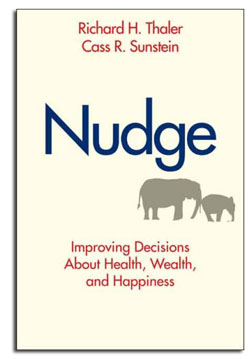 The thesis of “Nudge” is that it is possible to design choices to make it easy to do what is good for us and just a tiny bit harder to do what is bad for us, thus government should create policies that “nudge” us in the right direction.
The thesis of “Nudge” is that it is possible to design choices to make it easy to do what is good for us and just a tiny bit harder to do what is bad for us, thus government should create policies that “nudge” us in the right direction.
“Nudge” begins with an illustration of a school cafeteria manager who discovers how students can be influenced toward healthy nutrition by how cafeteria offerings are placed, arranged, and displayed: “good” food at eye level, “bad” food at the back of a display, placing it where it is hard to reach, or toward the end of a line.
The authors term such a person a “choice architect.” They go on to discuss the emerging science of choice and the Reflective Mind vs. the Automatic Mind.
The classic example is where the default option for new employees is to be enrolled in the company 401(k) plan. It is not mandatory, you can opt out, but if you do nothing, you are enrolled. A variant on this is called pre-choice: raises are automatically rolled into the 401(k) plan. You can always choose differently when the time comes but most people don’t.
Thaler calls this “libertarian paternalism,” defined as the “gentle nudging of the citizenry in the right direction” and argues: “It is often possible to design policies, in both the public and private sector, that make people better off — as judged by themselves — without coercion. We oppose bans; instead, we favor nudges. Since it is often impossible for private and public institutions to avoid picking some option as the default, why not pick one that is helpful?”
This is called “choice architecture” and similar to physical architecture, there are no “neutral” choices. Among other things the evolving science of choice takes advantage of the tendency of people to procrastinate, make decisions by indecision, and to take the path of least resistance. Indeed, it can be argued that humans are not very good decision-makers (see Predictably Irrational, The Drunkard’s Walk, and Sway) and are “riddled with little psychological tics in our decision-making processes. We buy things, then suffer remorse. We get confused by choices and often make no choice at all.”
The authors derived the term NUDGE:
iNcentives
Understand choice mapping
Defaults matter
Give Feedback
Expect Error
Structure complex choices
Another nudge is the act of disclosure: Imagine if the most prominent thing you saw when you opened your monthly credit card bill was the dollar amount of interest you paid year to date and the interest rate you were paying. How would your behavior change? Or what if instead of the EPA milage, new car stickers showed the estimated cost in dollars of 5 years of driving? This touches upon another aspect of nudge philosophy and good choice architecture: provide timely and relevant feedback about choices and outcome; real time, useful feedback.
Good choice architecture also “expects error and develops systems to prevent, detect, and minimize it. For example, pill cases and inhalers with dosage counters are simple and valuable ways to reduce the frequent errors people make in remembering medication. Psychological research provides direction as to what kinds of errors are to be expected when people are making decisions.”
The study of choices, what drives them and how to help people make better decisions can powerfully help people live better lives. It also can map the road to subtle totalitarianism.
NOTE: This blog owes much to amazon.com reviews by Robert D. Steele, D. Stuart, and Alan Schwartz.


0 Comments